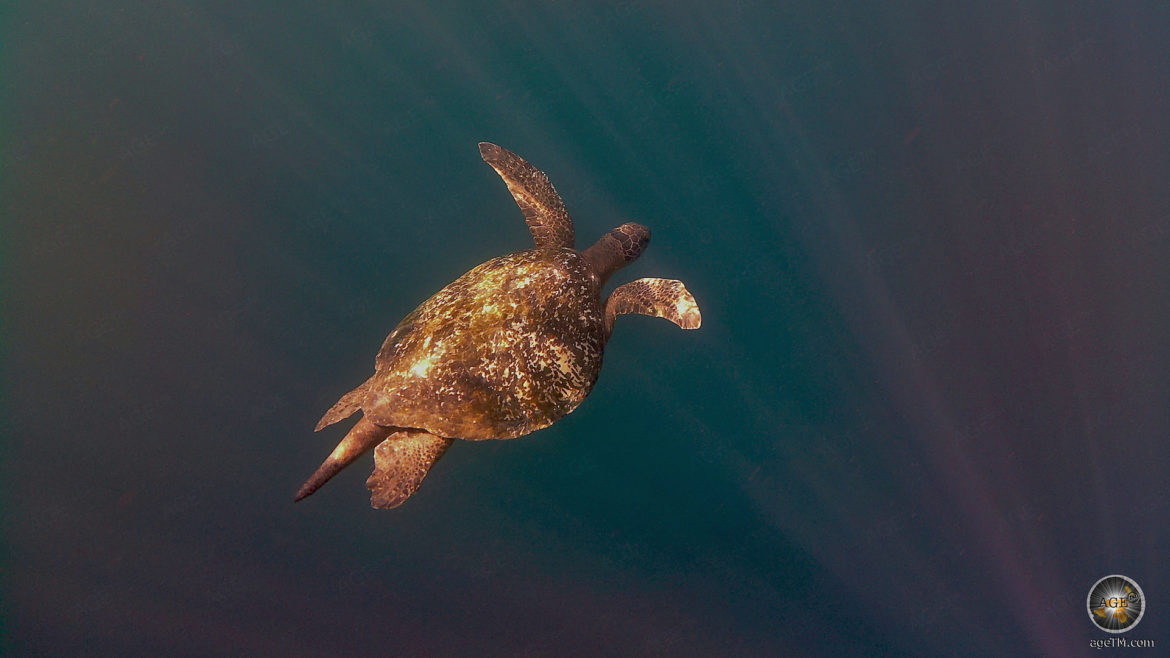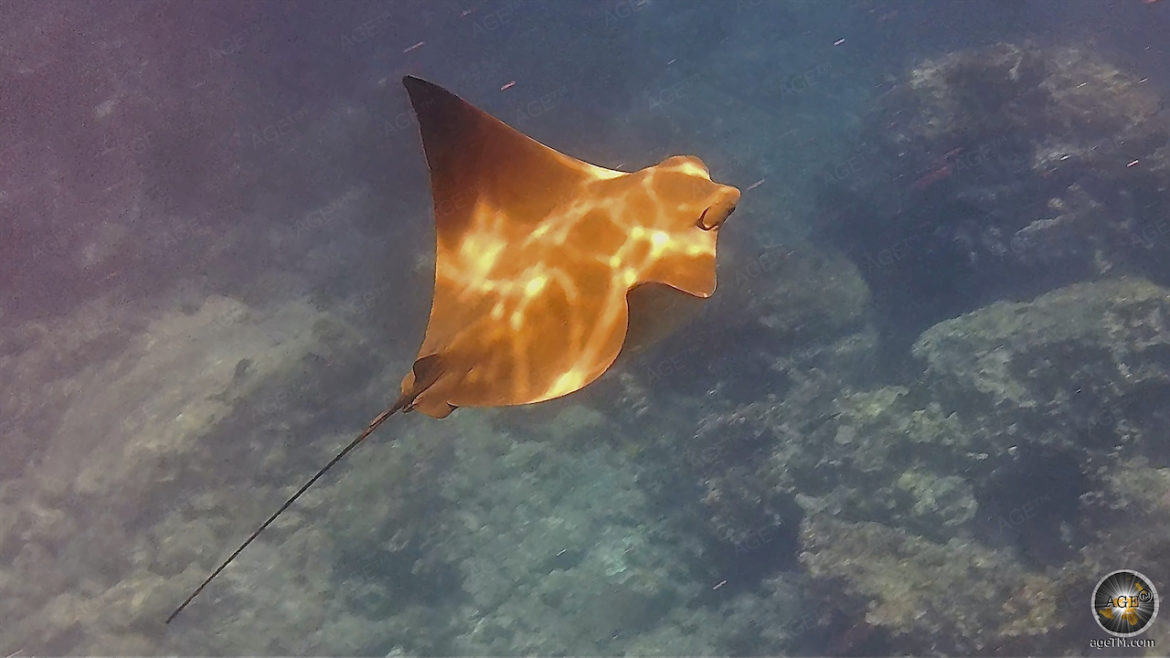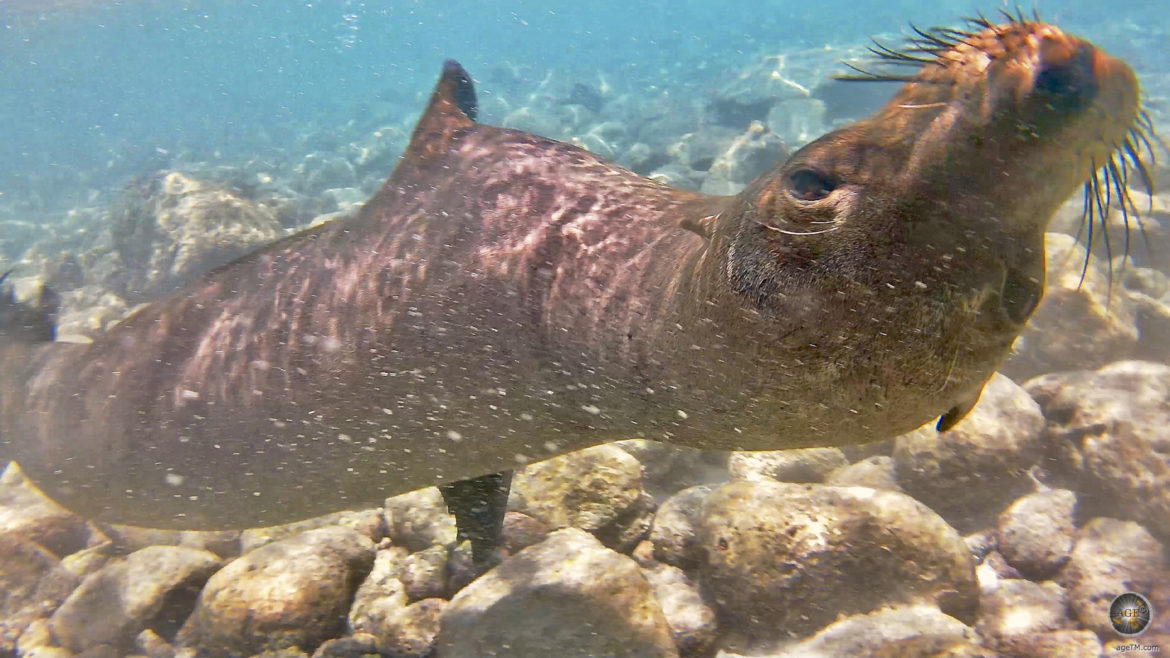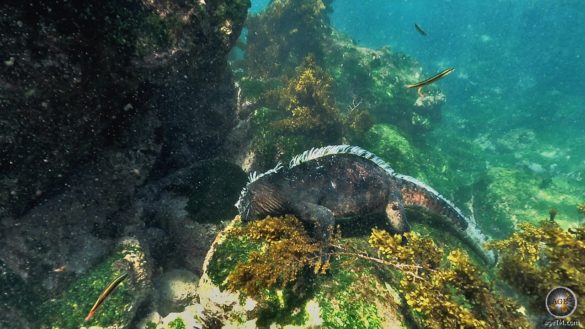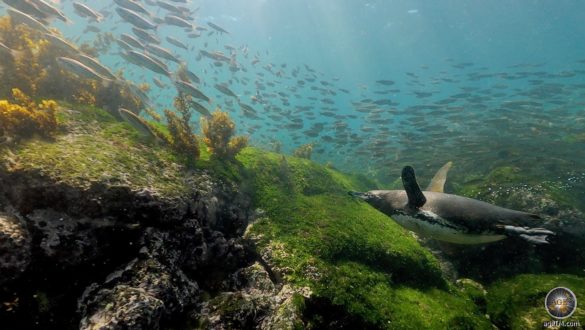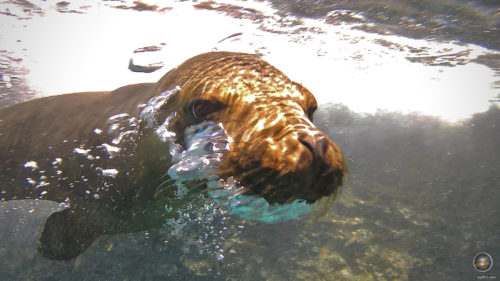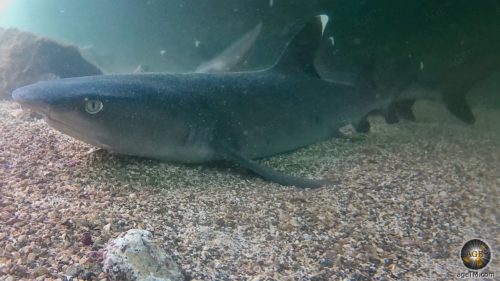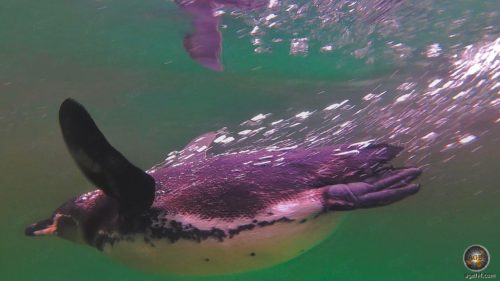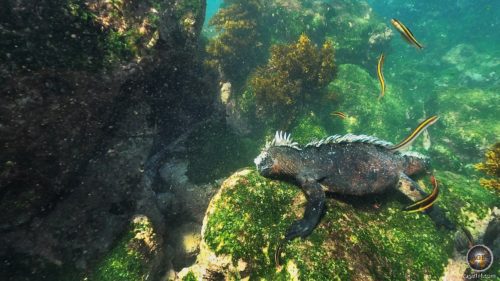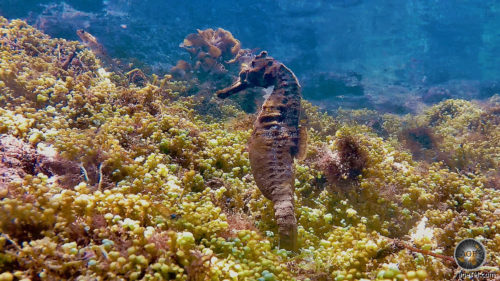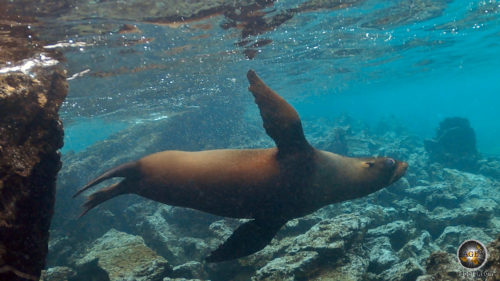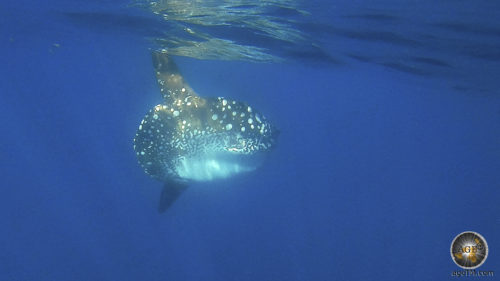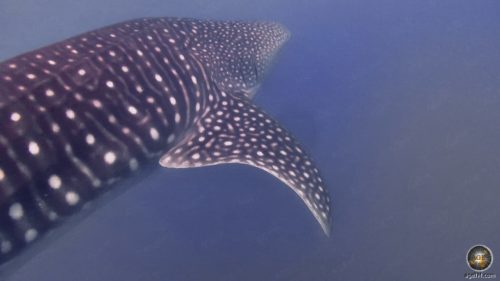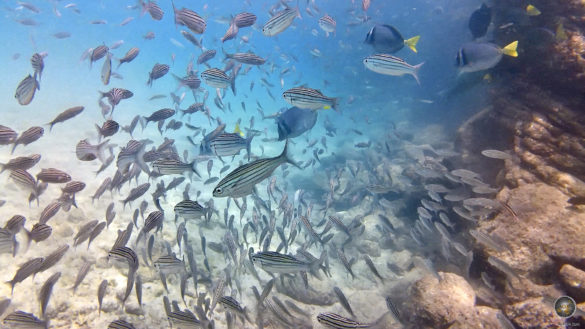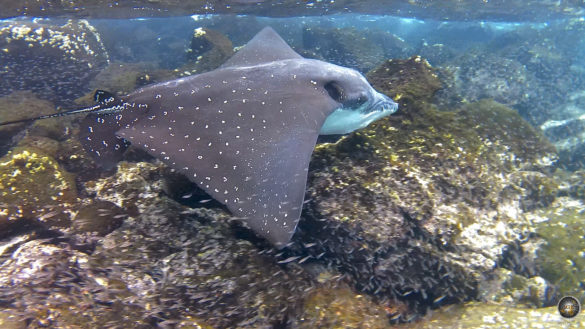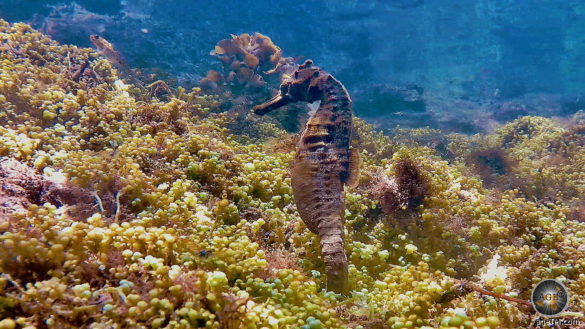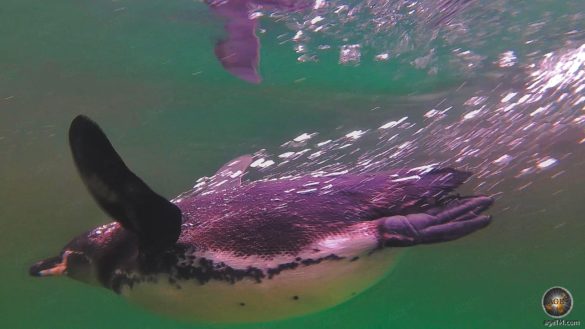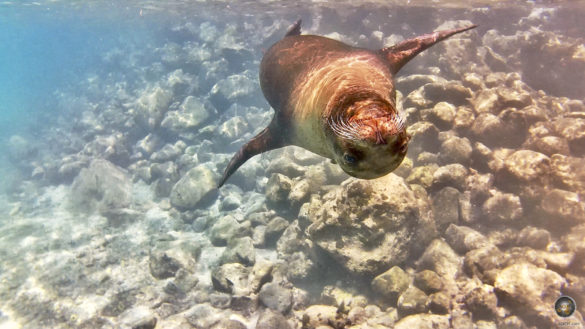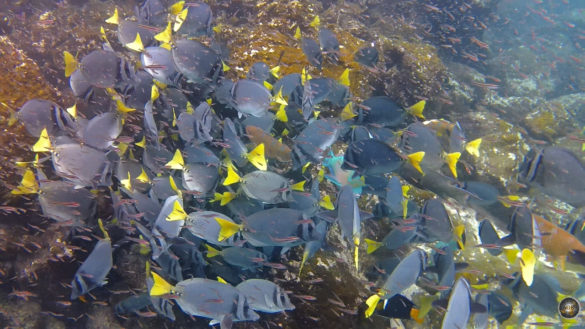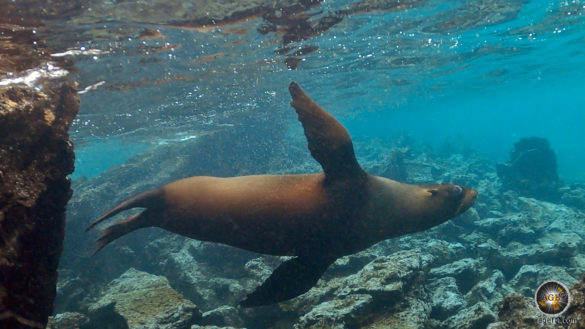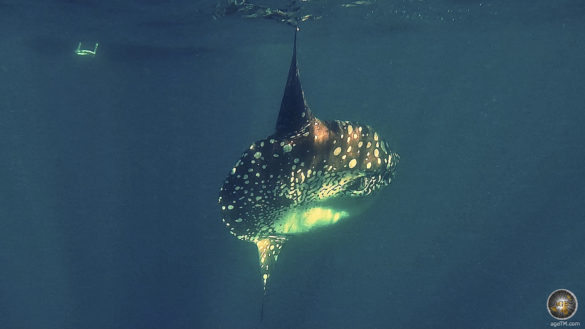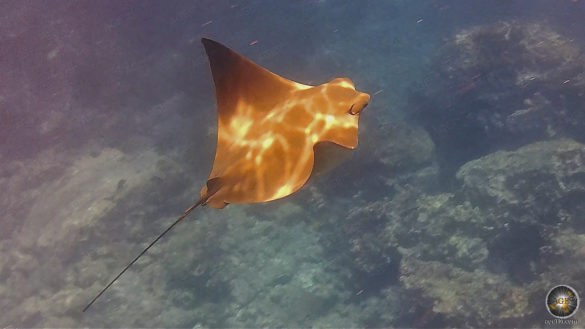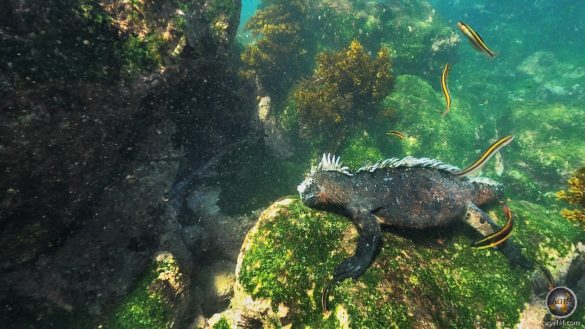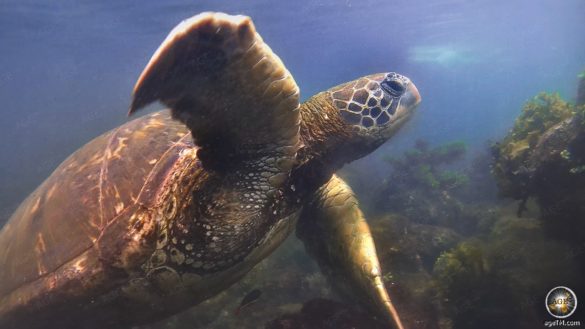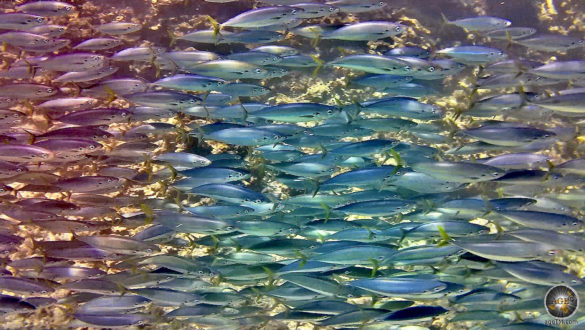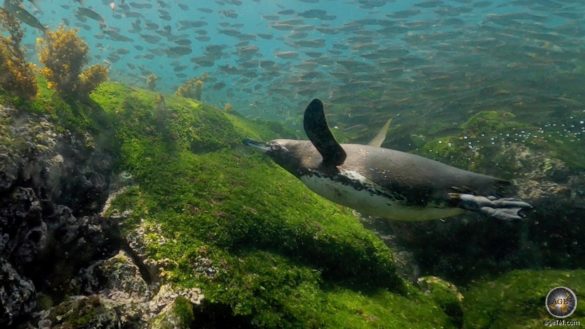Pure fascination!
Galapagos underwater leaves you speechless. Surgeonfish, parrotfish, puffer fish, barracuda, eagle rays, golden rays and stingrays are just a few of the many fish species that live here. The abundance of sharks is also remarkable. Snorkelers and divers can spot whitetip and blacktip reef sharks, as well as hammerheads and Galapagos sharks. Green sea turtles find plenty of food, mate and lay eggs on deserted beaches. In addition, the UNESCO World Natural Heritage also impresses underwater endemic specieswho only live here in the world. Watching marine iguanas eat, snorkeling with Galapagos penguins and swimming in a playful colony of Galapagos sea lions – all of this becomes a reality underwater in the Galapagos. With a bit of luck you can even get one on liveaboards or cruises Mola Mola and whale Sharks see. One thing is certain: the Galapagos Archipelago has a lot to offer, not just on the water. There is also a paradise beneath the surface of the sea. The Galapagos Marine Reserve stretches over 133.000 km2 and is home to numerous marine animals.
Experience the fantastic diversity of the underwater world of the Galapagos ...
Fascinated, I watch the primeval face of a marine iguanas that is eating its algae meal with relish. Small, attentive dragon eyes. Noticeably broad lips. Rounded, keel-shaped scales and large nostrils on a blunt, short nose. Then a huge school of small fish obscures my gaze and a movement in the corner of my eye catches my attention. As if by magic, the swarm parted and a chasing penguin whizzed past me. I am still amazed when suddenly a black bird glides elongated through the water and successfully finishes its fishing under the incredulous gaze of my diving goggles. Wow. A flightless cormorant in action. I learn to be amazed every minute. "
Fascinated, I watch the primeval face of a marine iguanas that is eating its algae meal with relish. Small, attentive dragon eyes. Noticeably broad lips. Rounded, keel-shaped scales and large nostrils on a blunt, short nose. Then a huge school of small fish obscures my gaze and a movement in the corner of my eye catches my attention. As if by magic, the swarm parted and a chasing penguin whizzed past me. I am still amazed when suddenly a black bird glides elongated through the water and successfully finishes its fishing under the incredulous gaze of my diving goggles. Wow. A flightless cormorant in action. I learn to be amazed every minute. "
Wildlife Viewing • Galapagos • Snorkeling and diving in the Galapagos • Galapagos underwater • Diashow
Swimming with sea lions
Endemic Galapagos sea lions (Zalophus wollebaeki) are one of the many highlights of the Galapagos National Park. The inhabited island San Cristobal has a large colony of sea lions. Tours to the uninhabited islands espanola and Santa Fe offer good opportunities to snorkel with sea lions in clear water. Even on a day trip to Floreana or Bartholomew or on Galapagos cruise you can share the water with sea lions. The playful animals are in Galapagos National Park unusually relaxed and don't seem to perceive humans as a threat. Diving in the Galapagos, with good chances of seeing sea lions, is for example in San Cristobal, espanola and North Seymour is possible.
- Sea lion snorkeling at Pinnacle Rock Bartolome Island. Swimming with sea lions Underwater wildlife viewing
Snorkel with whitetip reef sharks
Whitetip reef sharks are common in the Galapagos and can be seen on many snorkeling tours and dives. at the tunnels Whitetip reef sharks are very common and often even to be found in groups resting in small caves. Even with day trips, e.g. to espanola, Bartholomew or North Seymour, sightings of individual whitetip reef sharks are possible. As part of a Cruise in Galapagos you can experience a snorkeling tour at Devils Crown and have a good chance of seeing reef sharks and maybe even Galapagos sharks or hammerheads. Diving and snorkeling with sharks is very popular in the Galapagos and is considered safe.
- Resting Whitetip Reef Shark, Los Tuneles, Isabela Island, Galapagos
Observation of sea turtles
Green sea turtles are found around the Galapagos Archipelago and cavort on several coasts. On a half day tour from Isabela to the tunnels or on one Galapagos cruise at Punta Vicente Roca on the Isabela's back you have the best chances. Here you can usually see a larger number of the beautiful animals with just one snorkeling trip. Also on the west coast of San Cristobal sea turtles are frequent guests. At Kicker Rock, the hammerhead sharks are the highlight, but sea turtles are also common.
On the beach at Punta Cormorant from Floreana swimming is prohibited. With a little luck you can watch the mating of sea turtles from land here in spring. You can reach this beach by day trip from Santa Cruz or with one Galapagos cruise. This area is not accessible during a private stay on Floreana.
- Green sea turtle animal photo in Galapagos National Park, UNESCO World Heritage Site, Ecuador
Diving with hammerhead sharks
On a Liveaboard diving in the Galapagos you have the best conditions for numerous encounters with this predatory fish. The dive sites of the islands Wolf + Darwin are by far the best place to dive with sharks and are known for large schools of hammerhead sharks. The particularly active one Galapagos cruise with the Motor sailor Samba passengers have two chances to experience hammerhead sharks while snorkeling. In the caldera of an old volcanic crater the Genovesa Island and around the eroded volcanic crater Devils Crown near by Floreana.
If you want to visit the Galapagos without a cruise, you have to dive at the steep wall Kicker Rock (Leon Dormido) good chances of hammerheads. Day trips to this special spot start from San Cristobal. Schools of hammerhead sharks also occasionally swim by here. On days with particularly clear visibility, even snorkelers can see hammerhead sharks in the Deep Blue. Tours to the Gordon Rocks dive site are available from Santa Cruz. This dive site is also known as a good hammerhead spot.
- 20 hammerhead sharks diving at Kicker Rock in front of San Cristobal, Galapagos National Park, Ecuador
Snorkeling with penguins
The Galapagos penguins are an endemic species. They are only found on a few islands in the Galapagos Archipelago and their number has unfortunately been greatly reduced due to the El Niño weather phenomenon. In the inhabited area of the Isabela Island even a small colony lives near the port of Puerto Villamil. Here you can discover penguins on your own with your snorkeling equipment and a little luck.
On Cruise in Galapagos do you have before Fernandina Island and at Cape Douglas on the Back of Isabela best opportunities to experience penguins actively in the water. Another chance to see the cute birds is on a half-day tour to los tunes, the kayak snorkeling tour Tintoreras or a day trip to Bartholomew.
- Galapagos penguin at Concha de Perla, Isabela Island, Galapagos
Experience marine iguanas underwater
Marine iguanas should not be missing on your underwater excursion in the Galapagos. They only live in Galapagos and are found on all Galapagos Islands. The subspecies differ significantly in their size. Seeing marine iguanas in the Galapagos is almost guaranteed, but seeing them while eating in the water is much more difficult.
By far the best place to see marine iguanas eating is Cape Douglas on the Back of Isabela. But also at Punta Espinosa before the Fernandina Island your chances are good. You can reach both places with one Cruise in Galapagos or with one Liveaboard. With a little luck you will see on the Isabela Island at Concha de Perla or with a Tintoreras kayak snorkel tour, even without a ship, marine iguanas in the water.
- Eating marine iguanas off Fernandina Island, Galapagos National Park, Ecuador
Sighting seahorses
Well-known places for seahorses in the Galapagos are Los Tuneles and Punta Moreno. the tunnels can be reached with a half-day excursion from Isabela. Punta Morena is a popular snorkeling spot on the Back of Isabela and can with a Cruise in Galapagos be approached. Seahorses can be found in both very shallow and deeper water. The seahorses usually hold on to a branch or in the seagrass with their tail. It takes time and a trained eye to discover them.
- Seahorses at Los Tuneles, Isabela Island, Galapagos National Park
Splashing with fur seals
On Cruise in Galapagos you can also find lonely and remote islands like Marchena reach. In the lava pools on this island you can see fur seals in the water. Fur seals, like sea lions, belong to the ear seal family. Once you've looked into the round, googly eyes of a fur seal, you'll never confuse it with a sea lion again. These eyes are incredibly big. The Galapagos fur seal is the smallest species of the southern fur seal and is critically endangered.
- Fur seal in the lava pools of Marchena Island, Galapagos Ecuador
See a Mola Mola once in a lifetime
Punta Vincente Roca on the uninhabited Back of Isabela is a well known dive site for Mola Mola. It is located on the northern tip of the island of Isabela in the immediate vicinity of the equator line and can be used on a liveaboard or on a Cruise in Galapagos be approached. On the northwest route with the Motor sailor Samba you have a good chance of spotting Mola Molas from on board. In very good conditions, you can even snorkel with a sunfish from an inflatable boat.
- Sunfish Sunfish Mola Mola at Punta Vicente Roca, Galapagos Isabela Island
Swim with whale sharks
In the Galapagos, divers have a good chance of meeting the rare giants, especially between July and November. However, this is only to be expected in very remote areas. on Cruise in Galapagos whale sharks can occasionally be found in the channel between the Back of Isabela and the Fernandina Island to be spotted. Intense encounters with whale sharks while diving are on diving Safari around the remote Wolf + Darwin Islands is possible.
- Whale shark underwater photo Diving with the largest fish on earth
Wildlife Viewing • Galapagos • Snorkeling and diving in the Galapagos • Galapagos underwater • Diashow
Enjoy the AGE ™ picture gallery: Galapagos under water - a paradise in itself.
(For a relaxed slide show in full format, simply click on a photo and use the arrow key to move forward)
Wildlife Viewing • Galapagos • Snorkeling and diving in the Galapagos • Galapagos underwater • Diashow
UNESCO World Heritage Center (1992 to 2021), Galapagos Islands. [online] Retrieved on November 04.11.2021th, XNUMX, from URL:
https://www.galapagos.org/about_galapagos/about-galapagos/the-islands/genovesa/

